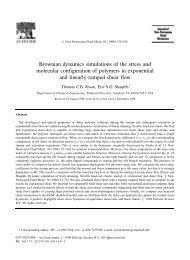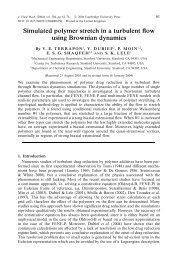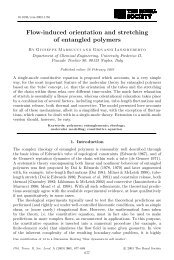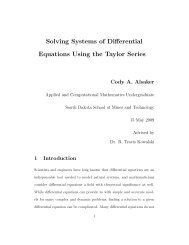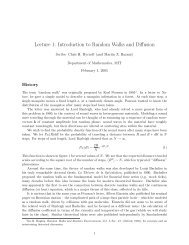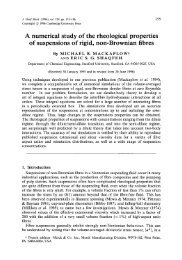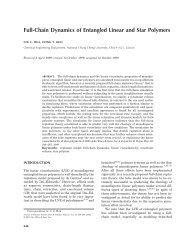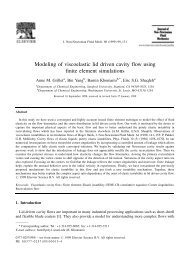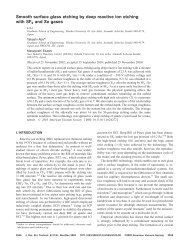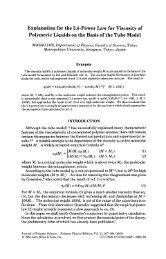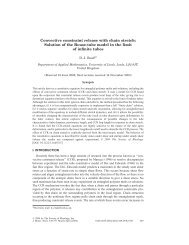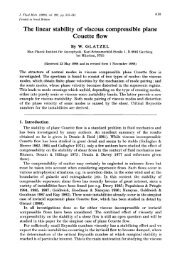Molecular modelling of entangled polymer fluids under flow The ...
Molecular modelling of entangled polymer fluids under flow The ...
Molecular modelling of entangled polymer fluids under flow The ...
Create successful ePaper yourself
Turn your PDF publications into a flip-book with our unique Google optimized e-Paper software.
1.6. NON-LINEAR RHEOLOGY 9<br />
1.5.2 Linear continuous shear<br />
Equation 1.10 can also be used to model a constant rate forward deformation provided<br />
that the deformation rate is small in comparison to the longest relaxation time <strong>of</strong> the<br />
material. For a continuous shear deformation commencing at time t = 0 the model<br />
predicts,<br />
σ xy (t) =<br />
∫ t<br />
0<br />
G(t − t ′ ) ˙γdt ′ . (1.16)<br />
In these shear experiments the transient shear viscosity, η + (t) = σ xy (t)/ ˙γ, is <strong>of</strong>ten<br />
plotted as a function <strong>of</strong> time. In this plot a Newtonian fluid would show a constant<br />
response at all deformation rates (see figure 1.1). For a linear viscoelastic fluid, whose<br />
constitutive equation is given by equation 1.8, the transient shear viscosity, η 0 (t), will<br />
be independent <strong>of</strong> the applied shear rate. This behaviour is seen in <strong>polymer</strong>ic <strong>fluids</strong><br />
at low shear rates (less than the reciprocal <strong>of</strong> the longest relaxation time) and also at<br />
early times when the applied strain, ˙γt, is small. Under these conditions the material<br />
is described as being in linear response. <strong>The</strong> master curve can be obtained from the<br />
linear relaxation spectrum. If G(t) is taken to be the sum <strong>of</strong> independent Maxwell<br />
modes (equation 1.15) then equation 1.16 gives<br />
η 0 (t) = ∑ i<br />
g i τ i [1 − exp(−t/τ i )] . (1.17)<br />
At higher deformation rates the transient curves <strong>of</strong> <strong>polymer</strong>ic <strong>fluids</strong> <strong>of</strong>ten deviate from<br />
linear response at strains <strong>of</strong> order one. <strong>The</strong> form <strong>of</strong> the deviation can be used to classify<br />
the material’s non-linear response.<br />
A similar transient viscosity, based on the first normal stress difference, can be<br />
defined for extensional <strong>flow</strong>s η + E (t) = N 1/˙ɛ. Using equation 1.8 it can be shown that,<br />
for a linear viscoelastic fluid in uniaxial extension, η + E (t) = 3η 0(t).<br />
1.6 Non-linear rheology<br />
Non-linear rheology refers to <strong>flow</strong>s in which the strain rates and accumulated strains<br />
are large. More specifically, the strain rate must be faster than some characteristic<br />
time <strong>of</strong> the material, usually the terminal time. Strains must be <strong>of</strong> order one or larger<br />
to observe non-linear effects. <strong>The</strong>se <strong>flow</strong>s are useful for a number <strong>of</strong> reasons. Nonlinear<br />
measurements on <strong>polymer</strong> liquids <strong>of</strong>ten show very striking behaviour and can,<br />
consequently, be more sensitive to molecular details than weaker deformations. For<br />
example, the extensional rheology <strong>of</strong> a polydisperse system can be strongly dependent<br />
on the high molecular weight tail <strong>of</strong> the distribution. A material’s response to different<br />
deformation geometries is <strong>of</strong>ten qualitatively different <strong>under</strong> non-linear deformations.



